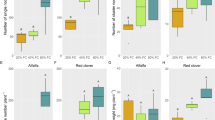Abstract
An investigation was carried out on the mycorrhizal colonisation, growth and nutrition of two members of the Ericaceae in close proximity to an arbuscular mycorrhizal (AM) association. This was undertaken by separating mycorrhizal (EM) and non-mycorrhizal (NEM) Erica cinerea and Vaccinium macrocarpon from AM (inoculated by Glomus mosseae) and non-mycorrhizal (NAM) Plantago lanceolata using a 30 µm nylon mesh in a sand culture/pot system. Ericoid mycorrhizal colonisation by Hymenoscyphus ericae on root systems of E. cinerea and V. macrocarpon was in the range 14–22% and 58–69%, respectively. The presence of AM P. lanceolata had no effect on the ericoid mycorrhizal colonisation of E. cinerea and V. macrocarpon. NEM E. cinerea showed reductions in shoot biomass and shoot nitrogen concentrations after exposure to AM P. lanceolata after incubations of 6 and 9 weeks but there were no differences in dry mass, length, and nitrogen and phosphorus concentrations of the root systems between the treatment combinations. Reductions were also found, after incubations of 6 and 9 weeks, in shoot dry mass, leaf area and shoot nitrogen concentrations of NEM V. macrocarpon in the presence of AM P. lanceolata but no changes occurred in the length and dry mass of the root systems. There were no differences in maximum photosynthesis in V. macrocarpon between treatment combinations but NEM V. macrocarpon in the presence of AM P. lanceolata had the lowest transpiration rates and stomatal conductance and the highest nitrogen- and phosphorus-use efficiencies compared with the other treatment combinations. These results are discussed in relation to the type of interaction found in these compatible and incompatible mycorrhizal associations.

Similar content being viewed by others
References
Allen EB, Allen MF (1984) Competition between plants of different successional stages: mycorrhizae as regulators. Can J Bot 62:2625–2629
Allen EB, Allen MF (1986) Water relations of xeric grasses in the field: interactions of mycorrhizas and competition. New Phytol 104:559–571
Allen EB, Allen MF (1988) Facilitation of succession by the non-mycotrophic colonizer Salsola kali (Chenopodiaceae) on a harsh site: effects of mycorrhizal fungi. Am J Bot 75:257–266
Allen MF, Allen EB, Friese CF (1989) Responses of the non-mycotrophic plant Salsola kali to invasion by vesicular-arbuscular mycorrhizal fungi. New Phytol 111:45–49
Anderson AJ (1988) Mycorrhizae—host specificity and recognition. Phytopathology 78:375–378
Brundrett M, Melville L, Peterson L (1994) Practical methods in mycorrhiza research. Mycologue, Guelph
Caemmerer S von, Farquhar GD (1981) Some relationships between the biochemistry of photosynthesis and the gas exchange of leaves. Planta 153:376–387
Francis R, Read DJ (1994) The contributions of mycorrhizal fungi to the determination of plant community structure. In: Robson AD, Abbott LK, Malajczuk N (eds) Management of mycorrhizas in agriculture, horticulture and forestry. Kluwer, Dordrecht
Francis R, Read DJ (1995) Mutualism and antagonism in the mycorrhizal symbiosis, with special reference to impacts on plant community structure. Can J Bot 73 (Suppl):1301–1309
Giovanetti M, Lioi L (1990) The mycorrhizal status of Arbutus unedo in relation to compatible and incompatible fungi. Can J Bot 68:1239–1244
Giovanetti M, Avio L, Sbrana C, Citernesi AS (1993) Factors affecting appressorium development in the vesicular-arbuscular mycorrhizal fungus Glomus mosseae (Nicol & Gerd) Gerd & Trappe. New Phytol 123:115–122
Giovanetti M, Sbrana AS, Logi C (1994) Early processes involved in host recognition by arbuscular mycorrhizal fungi. New Phytol 127:703–709
Glenn MG, Chew FS, Williams PH (1985) Hyphal penetration of Brassica (Cruciferae) roots by a vesicular-arbuscular mycorrhizal fungus. New Phytol 99:463–472
Glenn MG, Chew FS, Williams PH (1988) Influence of glucosinolate content of Brassica (Cruciferae) roots on growth of vesicular-arbuscular mycorrhizal fungi. New Phytol 110:217–225
Grime JP, Mackay JML, Hillier SH, Read DJ (1987) Floristic diversity in a model system using experimental microcosms. Nature 328:420–422
Halliday P (1998) Dictionary of plant pathology. Cambridge University Press, Cambridge
Hendershot WH (1985) An inexpensive block digester for nitrogen determination in soil samples. Commun Soil Sci Plant Anal 16:1271–1278
Hewitt EJ (1966) Sand and water culture methods used in the study of plant nutrition. Commonwealth Agricultural Bureaux, Farnham Royal, Slough
Murphy J, Riley JP (1962) A modified single solution method for the determination of phosphate in natural waters. Anal Chim Acta 27:31–36
Radin JW (1984) Stomatal responses to water stress and to abscisic acid in phosphorus-deficient cotton plants. Plant Physiol 76:392–394
Radin JW (1989) Responses of transpiration and hydraulic conductance to root temperature in nitrogen- and phosphorus-deficient cotton seedlings. Plant Physiol 92:855–857
Radin JW, Ackerson RC (1981) Water relations of cotton plants under nitrogen deficiency. III. Stomatal conductance, photosynthesis and abscisic acid accumulation during drought. Plant Physiol 67:115–119
Tennant D (1975) A test of a modified line intersect method of estimating root length. J Ecol 63:995–1001
Zar JH (1974) Biostatistical analysis. Prentice-Hall, Englewood Cliffs, N.J.
Author information
Authors and Affiliations
Corresponding author
Rights and permissions
About this article
Cite this article
Byrne, K., Mitchell, D.T. Responses of mycorrhizal and non-mycorrhizal Erica cinerea and Vaccinium macrocarpon to Glomus mosseae . Mycorrhiza 14, 31–36 (2004). https://doi.org/10.1007/s00572-003-0273-2
Received:
Accepted:
Published:
Issue Date:
DOI: https://doi.org/10.1007/s00572-003-0273-2




